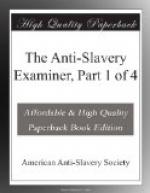common law. The declaration of Lord Chief Justice
Holt, that “by the common law, no man can have
property in another,” is an acknowledged axiom,
and based upon the well known common law definition
of property. “The subjects of dominion
or property are
things, as contra-distinguished
from
persons.” Let Congress adopt
the common law in the District of Columbia, and slavery
there is at once abolished. Congress may well
be at home in common law legislation, for the common
law is the grand element of the United States Constitution.
All its
fundamental provisions are instinct
with its spirit; and its existence, principles and
paramount authority, are presupposed and assumed throughout
the whole. The preamble of the Constitution plants
the standard of the Common Law immovably in its foreground.
“We, the people of the United States, in order
to ESTABLISH JUSTICE, &c., do ordain and establish
this Constitution;” thus proclaiming
devotion
to justice, as the controlling motive in the organization
of the Government, and its secure establishment the
chief object of its aims. By this most solemn
recognition, the common law, that grand legal embodiment
of “
justice” and fundamental right
was made the groundwork of the Constitution, and intrenched
behind its strongest munitions. The second clause
of Sec. 9, Art. 1; Sec. 4, Art. 2, and the last clause
of Sec. 2, Art. 3, with Articles 7, 8, 9, and 13 of
the Amendments, are also express recognitions of the
common law as the presiding Genius of the Constitution.
By adopting the common law within its exclusive jurisdiction
Congress would carry out the principles of our glorious
Declaration, and follow the highest precedents in
our national history and jurisprudence. It is
a political maxim as old as civil legislation, that
laws should be strictly homogeneous with the principles
of the government whose will they express, embodying
and carrying them out—being indeed the
principles themselves, in preceptive form—representatives
alike of the nature and the power of the Government—standing
illustrations of its genius and spirit, while they
proclaim and enforce its authority. Who needs
be told that slavery is in antagonism to the principles
of the Declaration, and the spirit of the Constitution,
and that these and the principles of the common law
gravitate toward each other with irrepressible affinities,
and mingle into one? The common law came hither
with our pilgrim fathers; it was their birthright,
their panoply, their glory, and their song of rejoicing
in the house of their pilgrimage. It covered
them in the day of their calamity, and their trust
was under the shadow of its wings. From the first
settlement of the country, the genius of our institutions
and our national spirit have claimed it as a common
possession, and exulted in it with a common pride.
A century ago, Governor Pownall, one of the most eminent
constitutional jurists of colonial times, said of the




